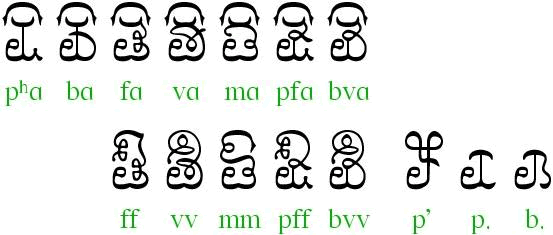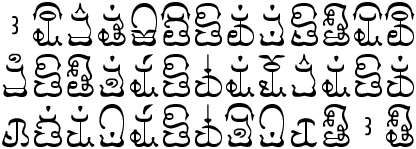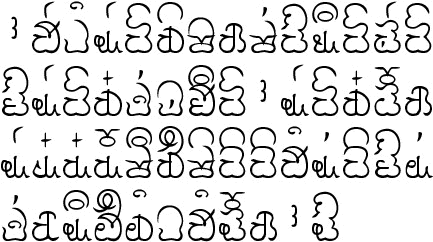The Sigil Panel script was invented by Ian James for SIGIL, and emerged when the author was struggling with the phonotactics of that language. Unlike the linear script, which simply shows the phoneme stream, this script breaks the stream into syllabic units. For SIGIL these units comprise at most two parts; most easily recognized are the consonant+vowel units.
Similar to the linear script, there are a number of consonantal bases, to which modifiers of articulation are attached. For convenience, the bases (which represent regions in the mouth) are labeled:

These go from front to rear: labial, dental, alveolar, alveolo-palatal, lateral, retroflex, palatal-velar, velar-uvular, and glottal.
The simple modifiers are: unvoiced plosive, voiced plosive, unvoiced fricative, voiced fricative, nasal, unvoiced affricate, and voiced affricate. Here they are shown next to a dotted circle which is where the consonantal base will sit:
![]()
Upon the base + simple modifier there is space for a vowel. Together, the consonant + vowel make a syllabic unit, which is drawn to fill a fixed-size rectangle (rather like Chinese characters). Not all base + modifier combinations make sense, but it is possible that unnatural combinations come to take on special, non-phonemic meanings.
There are also double modifiers, which fill a syllabic unit: double unvoiced fricative, double voiced fricative, double nasal, double unvoiced affricate, and double voiced affricate. This also shows the normal height of a full syllabic unit:

In addition, there are modifiers involving stoppage which are considered to take a whole syllabic unit: ejective, unvoiced stop, voiced stop (actually the stops are shorter in height than other units):

Here is the entire P series, showing how the parts join together. The vowel above the simply-modified consonants is /a/.

Above a single non-stopped consonant sits a single vowel. Here the vowel set is shown upon /m/ in red. A plosive may also go “without” a vowel, which means its inherent short, vague vowel schwa will be sounded.

The second vowel set here is of single vowels which are drawn to fill a syllabic unit. They are not “syllabic” in length, but their sound will end with a following consonant, which must signal the start of a new syllabic unit. A vowel in the lower position is referred to as an even-numbered vowel.
A sequence of vowels may occur, and may occur in both the lower and upper parts of a syllabic unit. The vowel in the upper position is referred to as an odd-numbered vowel.

It can also be seen here how a high tone is marked by a little tick in the bowl of the respective vowel.
The in-breath marker from the linear script is used unaltered (resembling the numeral 3), and stands in the space of a syllabic unit. This is used in a similar manner to comma. The symbol for out-breath is simply a double /h/, and together with a preceding in-breath forms a longer pause, similar to a period, or end-of-paragraph:

Also, blank syllable-wide spaces can be used to separate blocks of text in a general manner. On a page, the glyphs thus sit in a regular grid, not unlike the way Chinese characters are printed. And because of the way SIGIL is structured, lines can break after any syllable, not just between “words”.
This is a transliteration of the the first sentence of Article 1 of the Universal Declaration of Human Rights:

All human beings are born free and equal in dignity and rights.
Here is the rest of the Article in a quicker, less formal hand:

They are endowed with reason and conscience and should act towards one another in a spirit of brotherhood.
Feedback about Sigil Panel Script may be sent to [ianrjames at hotmail dotcom]
Akkhara Muni, Amethyst, Bostani, Elektrum, Fontok, Klaekson-Zaen, Maui, New Akha, New Maori, New Mong, Pranish, SIGIL, Sigil Panel Script, Slinseng-Fi, Tengwar for Scottish Gaelic, Xylphika
See also: http://www.skyknowledge.com/orthographies.htm
Constructed scripts for: Ainu | Arabic | Chinese languages | Dutch | English | Hawaiian | Hungarian | Japanese | Korean | Lingala | Malay & Indonesian | Persian | Tagalog / Filipino | Russian | Sanskrit | Spanish | Taino | Turkish | Vietnamese | Welsh | Other natural languages | Colour-based scripts | Tactile scripts | Phonetic/universal scripts | Constructed scripts for constructed languages | Adaptations of existing alphabets | Fictional alphabets | Magical alphabets | A-Z index | How to submit a constructed script
[top]
You can support this site by Buying Me A Coffee, and if you like what you see on this page, you can use the buttons below to share it with people you know.

If you like this site and find it useful, you can support it by making a donation via PayPal or Patreon, or by contributing in other ways. Omniglot is how I make my living.
Note: all links on this site to Amazon.com, Amazon.co.uk
and Amazon.fr
are affiliate links. This means I earn a commission if you click on any of them and buy something. So by clicking on these links you can help to support this site.
[top]